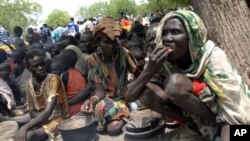The International Organization for Migration (IOM) says an estimated two million internally displaced people have returned to their places of origin in Southern Sudan since January 2005. That is when the governments in the north and south of the country signed a comprehensive peace agreement ending more than 20 years of civil war.
About four million people were displaced by 20 years of civil war in Sudan. The International Organization for Migration reports about half of them have now returned to the homes they fled. It says the largest number have gone back to Northern Bahr el Ghazal and Southern Kordofan.
IOM Spokesman Jean-Philippe Chauzy tells VOA the number of returnees peaked in 2006 and 2007, when about three-quarters of a million people returned each year to south Sudan.
"And, since then it has been declining. We have had about 360,000 people who returned in 2008. Last year, the numbers dropped to about 160,000," he noted. "Now what the report seems to indicate is that returns to south Sudan are picking up in the first two months of 2010 probably because of the forthcoming elections in April and, of course, because probably of the referendum that will take place in 2011-that is the referendum looking at the independence of south Sudan."
Chauzy says most of the people face enormous challenges upon their return. He says they have great difficulty accessing basic services. He says the returnees have difficulty in getting clean water, food, health care, education and jobs.
"For instance, the report clearly spells out that 60 percent of the families that have returned to south Sudan and south Kordofan are headed by women," he added. "They are single, female-household families and, therefore, they need more assistance because they are more vulnerable. The report also underlines that a big majority of the returnees are very young people. Sixty percent of the returnees are under the age of 18."
The IOM report says the humanitarian situation in south Sudan is critical. It notes extensive damage has been done to the infrastructure in the region during the long-lasting civil war.
The IOM says the infrastructure must be rebuilt and basic services must be made available to the millions of displaced who have returned home. Otherwise, it warns, these returns will not be sustainable and people, once again, will be on the move.
Sudan's Two Million Displaced Persons Return Home







